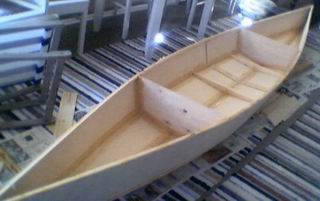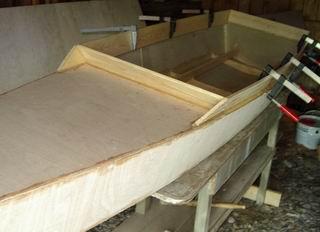
The curves don't look bad at all. Frictional resistance dominates, like with a real racing boat, and the values of the total resistance are low.

One day I decided I need a sculling training boat that is not of of "fishing boat" style, but rather of "olympic" style. With a sliding seat, and probably otriggers too.
The design criteria I had in mind:
I figured out these criteria could be fulfilled by a double ender plywood hull with a closed compartment in the bow and stern, and a sitting well in between. The material would be 4 mm (5/32") plywood, with stich and glue seams where possible. The seam between the boat side and the tops of the closed compartments (decks) is difficult to tape from the inside ;-), so these seams would have a thin chine log inside.
The boat width would be in the range 2'-3' (60-90 cm). Car toppability and ease of handling would point to a total weight of some 20 kg (45 lbs) and total length of around 5 m (16'). These figures again point to a solution "make it out of two sheets of plywood", each weighing about 8 kg (18 lbs).
So I ended up with this. The boat is 482 cm (15'10") long, with a 66 cm (26") beam.
First, here's the .hul file to start with.
Cut the plywood sheets following this pattern. Loft only the
yellow parts. Copy them, after cutting, onto the green.
The remaining red triangles will make the decks, they need not be
lofted. Once the hull is glued together, You can just put the
plywood triangles on top of the hull and draw along the sheerline.

Measurements for a bottom half.


And measurements for a side.


The bulkheads lie at 186 cm (73") and 348 cm (137") from the point of the bow.
The bulkhead closer to the bow is 576 mm (1' 10" 5) wide on the top, 480 mm (1' 6" 7) at the turn of the bilge. Total height is 265 mm (10" 4), out of which 31 mm (1" 2) is the depth of the bottom V.
The bulkhead closer to the stern is 552 mm (1' 9" 6) wide on the top, 488 mm (1' 7" 2) at the turn of the bilge. Total height is 260 mm (10" 2), out of which 33 mm (1" 2) is the depth of the bottom V.
I made the bulkheads out of 6.5 mm (1/4") ply.
 |
The curves don't look bad at all. Frictional resistance dominates, like with a real racing boat, and the values of the total resistance are low. |
Rt (violet curve) = total resistance
Rv (red curve) = viscous resistance (friction)
Rw (blue curve) = wave forming resistance
Rh (pale blue curve) = resistance created by transom stern
Full speed scale = 4.0 m/s = 14.4 km/h = 9.0 mph = 7.8 knots
First glue the side and bottom pieces together. Use some 65 mm (2 1/2") wide butt blocks at the intersection.
Be very careful to line the pieces up correctly! With these long and narrow pieces an error at the intersection multiples to an about tenfold error in the end of the piece.
Then build the hull just like any standard plywood tape and glue constuction
job. Use wire clips and duct tape to hold the pieces together.
Use just a narrow glass tape, 25 mm (1") or so.
 |
The hull and bulkheads glued and taped together. |
 |
From another angle. |
 |
There is no need to use any separate bow or stern stem pieces.
Just glue the sides together, against each other. |
 |
The same applies to the bow. Oops, the background is shining through! Some more filler needed! |
 |
The low triangular pieces on the bottom of the sitting well will be the supports for the sliding seat rails. |
 |
The decks glued in place... |
 |
...held temporarily by small nails. |
 |
The seams have been filled and sanded. I've started to build a coaming around the cockpit to raise the outriggers high enough. The outriggers are going to be very simple ones. |
The outriggers will be two lenghts of plank, attached to the top edge of the coaming, supported to the side.
The distances to the front and rear of the cockpit are from the point of the bow, as well as the distance to the center of buoyancy (the red line).

 |
Sliding seat rail bases have been glued to the bulkheads and the triangular bottom frames. The rails are 300 mm (12") apart. |